Case Study: Women Executives, Leadership in Fashion Industry
VerifiedAdded on 2022/11/26
|8
|1235
|376
Case Study
AI Summary
This case study examines the fashion industry's dynamics, focusing on the emergence and impact of women leaders. It explores the internal and external factors influencing fashion businesses through industry analysis, including political, economic, social, and technological aspects. The study compares leadership styles of men and women, highlighting differences in task focus, organizational structure preferences, and communication approaches. It also discusses the challenges and constraints faced by women executives, such as balancing work-life, achieving equal pay, limited leadership opportunities, and workplace harassment. Furthermore, it identifies key characteristics of successful women executives, such as continuous learning, strategic planning, creativity, and the ability to inspire others. The analysis draws on academic research and real-world examples to provide a comprehensive understanding of leadership in the fashion industry.
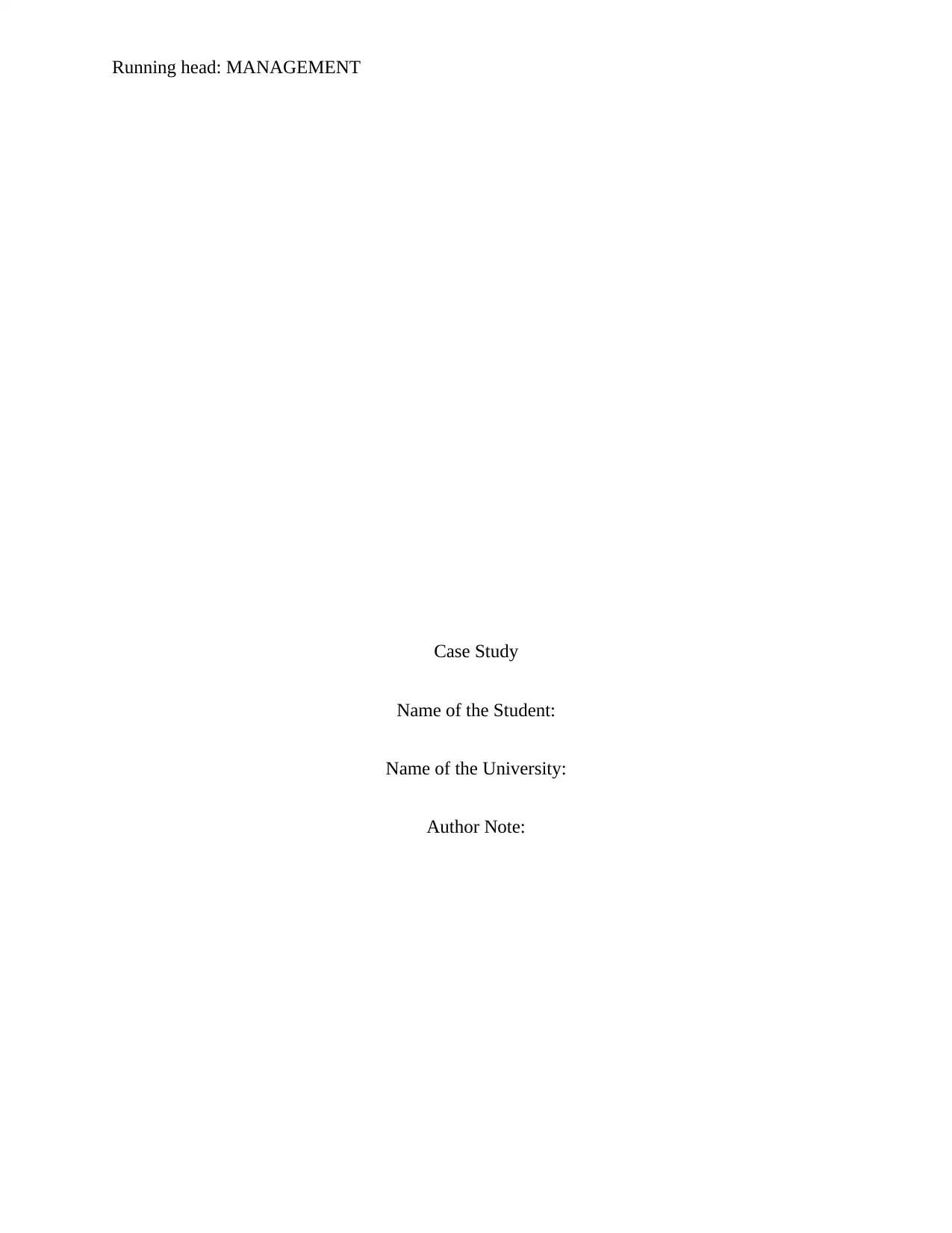
Running head: MANAGEMENT
Case Study
Name of the Student:
Name of the University:
Author Note:
Case Study
Name of the Student:
Name of the University:
Author Note:
Paraphrase This Document
Need a fresh take? Get an instant paraphrase of this document with our AI Paraphraser
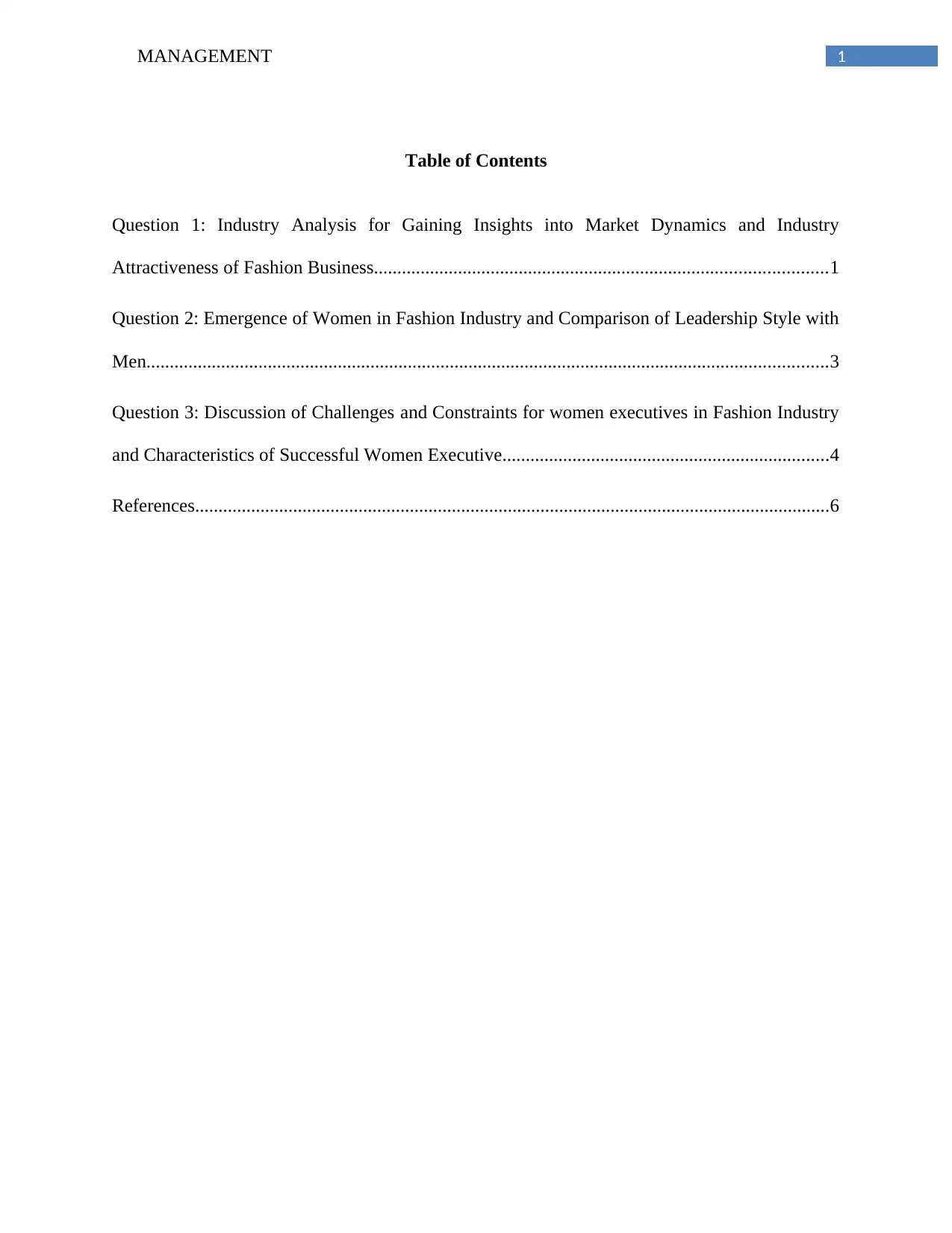
1MANAGEMENT
Table of Contents
Question 1: Industry Analysis for Gaining Insights into Market Dynamics and Industry
Attractiveness of Fashion Business.................................................................................................1
Question 2: Emergence of Women in Fashion Industry and Comparison of Leadership Style with
Men..................................................................................................................................................3
Question 3: Discussion of Challenges and Constraints for women executives in Fashion Industry
and Characteristics of Successful Women Executive......................................................................4
References........................................................................................................................................6
Table of Contents
Question 1: Industry Analysis for Gaining Insights into Market Dynamics and Industry
Attractiveness of Fashion Business.................................................................................................1
Question 2: Emergence of Women in Fashion Industry and Comparison of Leadership Style with
Men..................................................................................................................................................3
Question 3: Discussion of Challenges and Constraints for women executives in Fashion Industry
and Characteristics of Successful Women Executive......................................................................4
References........................................................................................................................................6
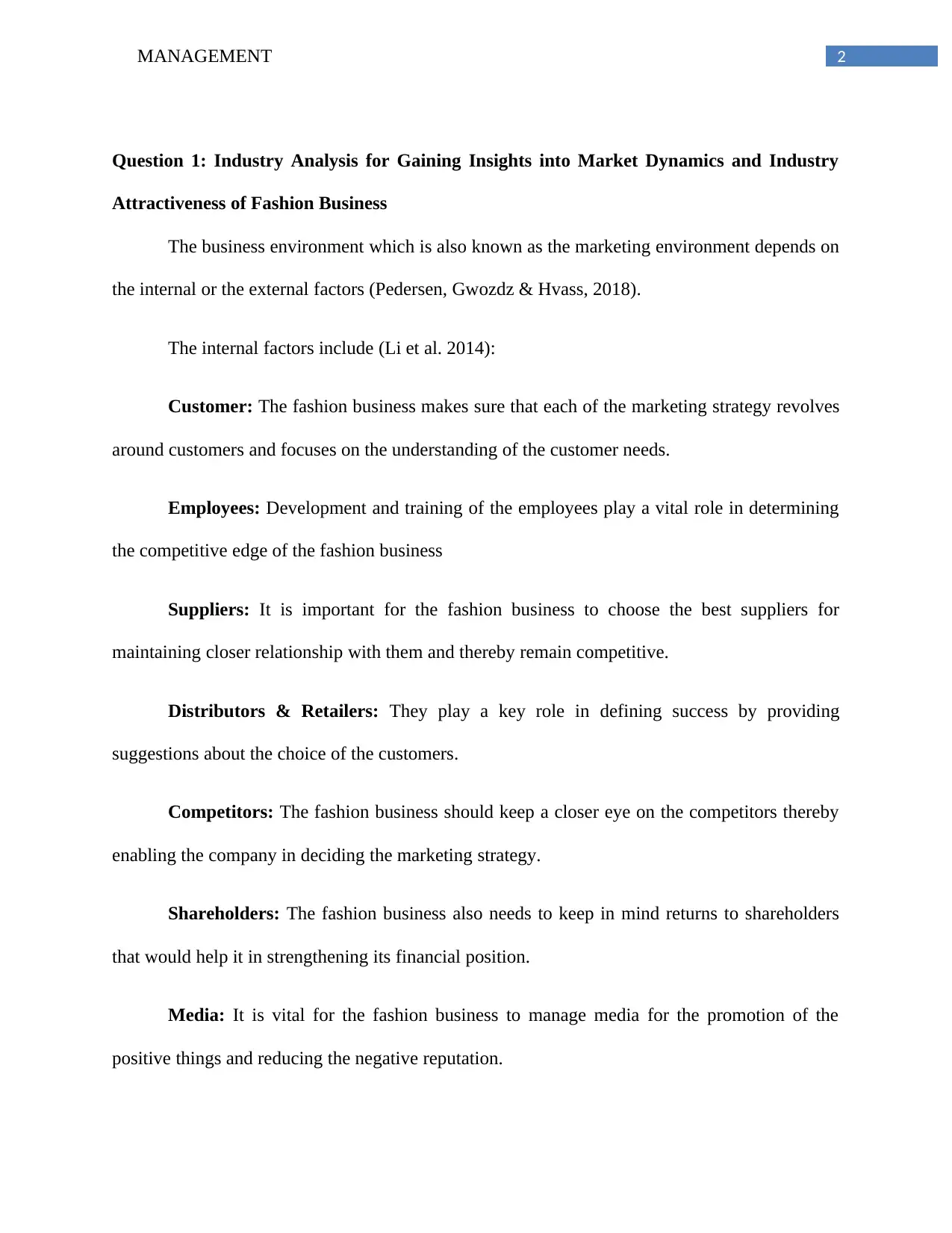
2MANAGEMENT
Question 1: Industry Analysis for Gaining Insights into Market Dynamics and Industry
Attractiveness of Fashion Business
The business environment which is also known as the marketing environment depends on
the internal or the external factors (Pedersen, Gwozdz & Hvass, 2018).
The internal factors include (Li et al. 2014):
Customer: The fashion business makes sure that each of the marketing strategy revolves
around customers and focuses on the understanding of the customer needs.
Employees: Development and training of the employees play a vital role in determining
the competitive edge of the fashion business
Suppliers: It is important for the fashion business to choose the best suppliers for
maintaining closer relationship with them and thereby remain competitive.
Distributors & Retailers: They play a key role in defining success by providing
suggestions about the choice of the customers.
Competitors: The fashion business should keep a closer eye on the competitors thereby
enabling the company in deciding the marketing strategy.
Shareholders: The fashion business also needs to keep in mind returns to shareholders
that would help it in strengthening its financial position.
Media: It is vital for the fashion business to manage media for the promotion of the
positive things and reducing the negative reputation.
Question 1: Industry Analysis for Gaining Insights into Market Dynamics and Industry
Attractiveness of Fashion Business
The business environment which is also known as the marketing environment depends on
the internal or the external factors (Pedersen, Gwozdz & Hvass, 2018).
The internal factors include (Li et al. 2014):
Customer: The fashion business makes sure that each of the marketing strategy revolves
around customers and focuses on the understanding of the customer needs.
Employees: Development and training of the employees play a vital role in determining
the competitive edge of the fashion business
Suppliers: It is important for the fashion business to choose the best suppliers for
maintaining closer relationship with them and thereby remain competitive.
Distributors & Retailers: They play a key role in defining success by providing
suggestions about the choice of the customers.
Competitors: The fashion business should keep a closer eye on the competitors thereby
enabling the company in deciding the marketing strategy.
Shareholders: The fashion business also needs to keep in mind returns to shareholders
that would help it in strengthening its financial position.
Media: It is vital for the fashion business to manage media for the promotion of the
positive things and reducing the negative reputation.
⊘ This is a preview!⊘
Do you want full access?
Subscribe today to unlock all pages.

Trusted by 1+ million students worldwide
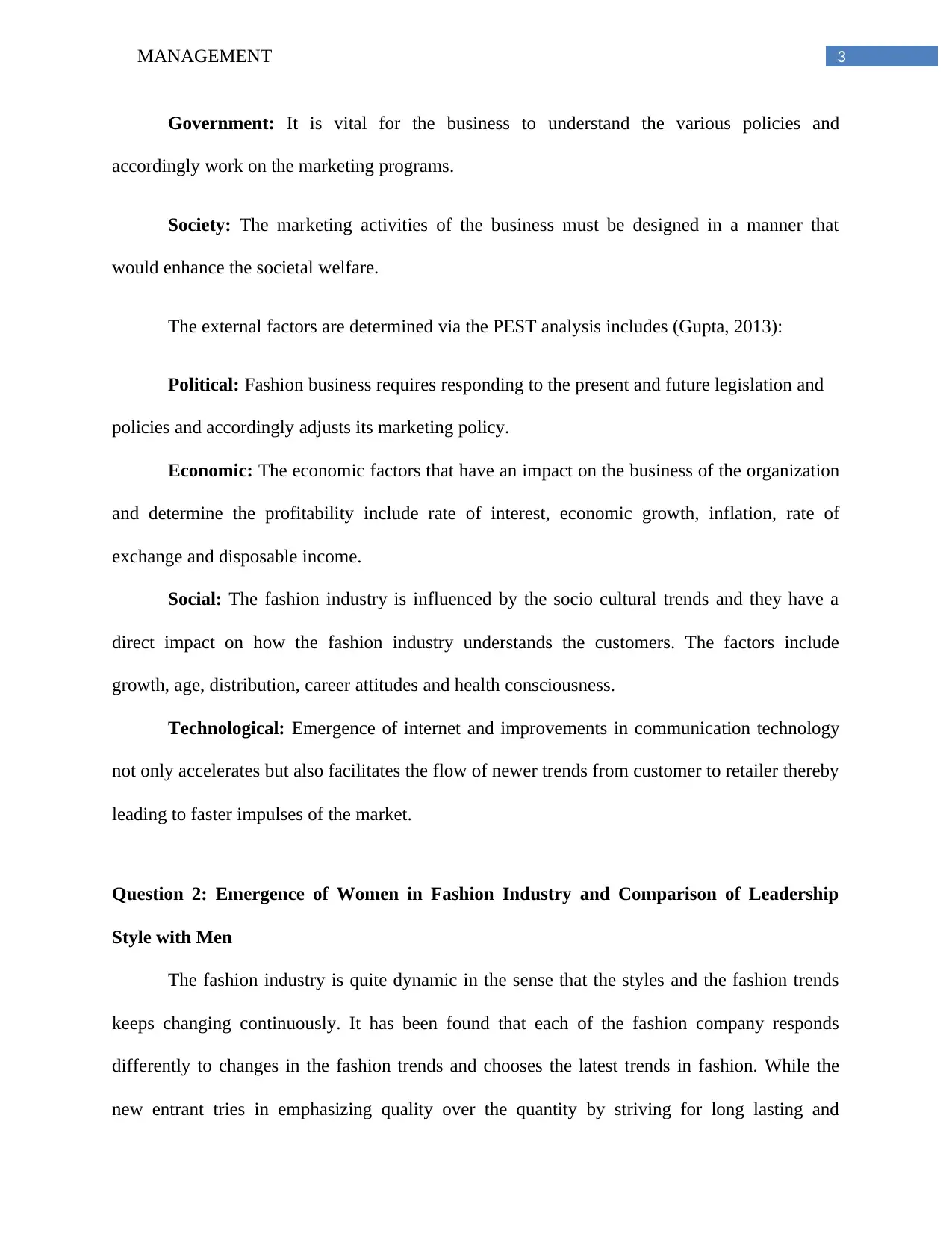
3MANAGEMENT
Government: It is vital for the business to understand the various policies and
accordingly work on the marketing programs.
Society: The marketing activities of the business must be designed in a manner that
would enhance the societal welfare.
The external factors are determined via the PEST analysis includes (Gupta, 2013):
Political: Fashion business requires responding to the present and future legislation and
policies and accordingly adjusts its marketing policy.
Economic: The economic factors that have an impact on the business of the organization
and determine the profitability include rate of interest, economic growth, inflation, rate of
exchange and disposable income.
Social: The fashion industry is influenced by the socio cultural trends and they have a
direct impact on how the fashion industry understands the customers. The factors include
growth, age, distribution, career attitudes and health consciousness.
Technological: Emergence of internet and improvements in communication technology
not only accelerates but also facilitates the flow of newer trends from customer to retailer thereby
leading to faster impulses of the market.
Question 2: Emergence of Women in Fashion Industry and Comparison of Leadership
Style with Men
The fashion industry is quite dynamic in the sense that the styles and the fashion trends
keeps changing continuously. It has been found that each of the fashion company responds
differently to changes in the fashion trends and chooses the latest trends in fashion. While the
new entrant tries in emphasizing quality over the quantity by striving for long lasting and
Government: It is vital for the business to understand the various policies and
accordingly work on the marketing programs.
Society: The marketing activities of the business must be designed in a manner that
would enhance the societal welfare.
The external factors are determined via the PEST analysis includes (Gupta, 2013):
Political: Fashion business requires responding to the present and future legislation and
policies and accordingly adjusts its marketing policy.
Economic: The economic factors that have an impact on the business of the organization
and determine the profitability include rate of interest, economic growth, inflation, rate of
exchange and disposable income.
Social: The fashion industry is influenced by the socio cultural trends and they have a
direct impact on how the fashion industry understands the customers. The factors include
growth, age, distribution, career attitudes and health consciousness.
Technological: Emergence of internet and improvements in communication technology
not only accelerates but also facilitates the flow of newer trends from customer to retailer thereby
leading to faster impulses of the market.
Question 2: Emergence of Women in Fashion Industry and Comparison of Leadership
Style with Men
The fashion industry is quite dynamic in the sense that the styles and the fashion trends
keeps changing continuously. It has been found that each of the fashion company responds
differently to changes in the fashion trends and chooses the latest trends in fashion. While the
new entrant tries in emphasizing quality over the quantity by striving for long lasting and
Paraphrase This Document
Need a fresh take? Get an instant paraphrase of this document with our AI Paraphraser
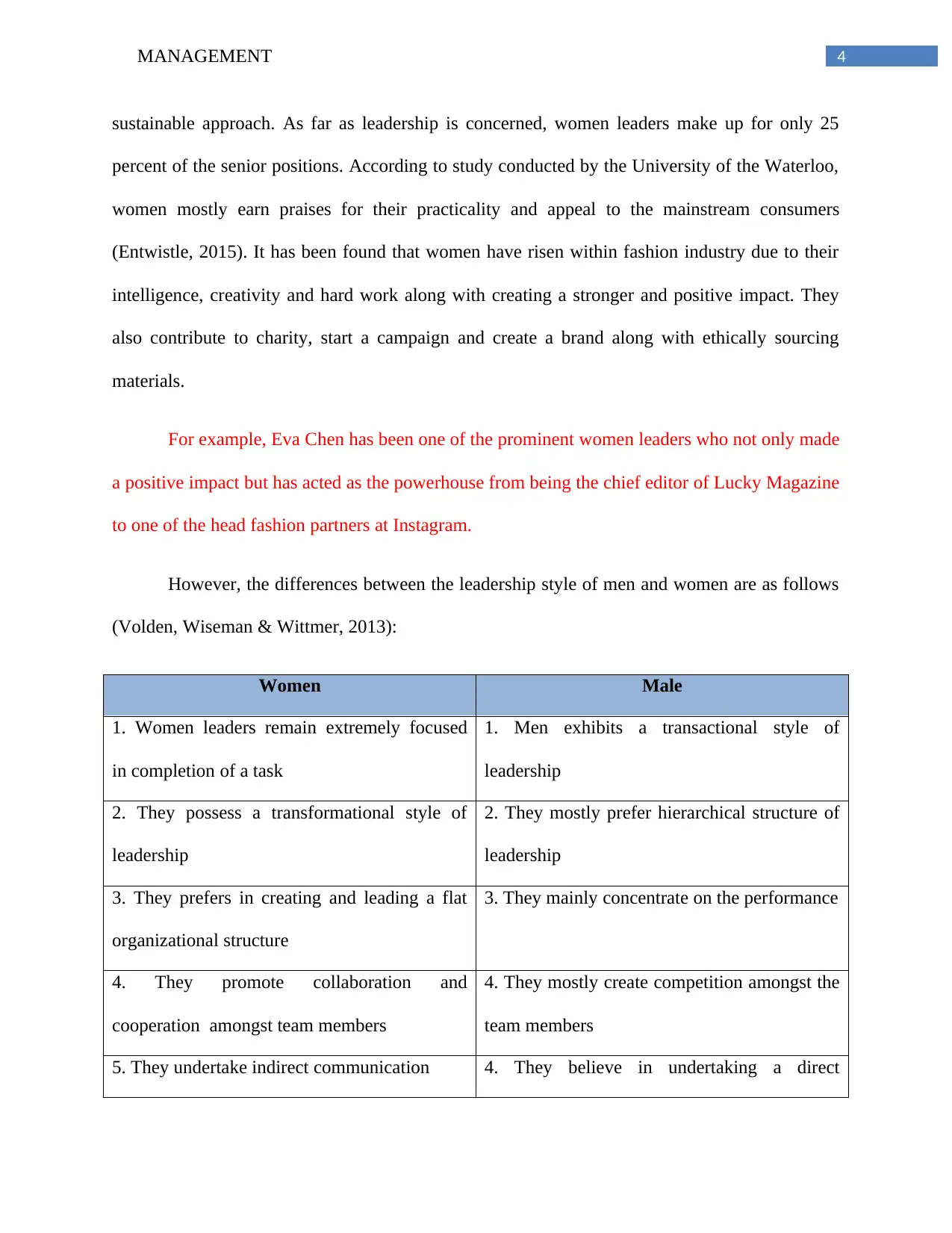
4MANAGEMENT
sustainable approach. As far as leadership is concerned, women leaders make up for only 25
percent of the senior positions. According to study conducted by the University of the Waterloo,
women mostly earn praises for their practicality and appeal to the mainstream consumers
(Entwistle, 2015). It has been found that women have risen within fashion industry due to their
intelligence, creativity and hard work along with creating a stronger and positive impact. They
also contribute to charity, start a campaign and create a brand along with ethically sourcing
materials.
For example, Eva Chen has been one of the prominent women leaders who not only made
a positive impact but has acted as the powerhouse from being the chief editor of Lucky Magazine
to one of the head fashion partners at Instagram.
However, the differences between the leadership style of men and women are as follows
(Volden, Wiseman & Wittmer, 2013):
Women Male
1. Women leaders remain extremely focused
in completion of a task
1. Men exhibits a transactional style of
leadership
2. They possess a transformational style of
leadership
2. They mostly prefer hierarchical structure of
leadership
3. They prefers in creating and leading a flat
organizational structure
3. They mainly concentrate on the performance
4. They promote collaboration and
cooperation amongst team members
4. They mostly create competition amongst the
team members
5. They undertake indirect communication 4. They believe in undertaking a direct
sustainable approach. As far as leadership is concerned, women leaders make up for only 25
percent of the senior positions. According to study conducted by the University of the Waterloo,
women mostly earn praises for their practicality and appeal to the mainstream consumers
(Entwistle, 2015). It has been found that women have risen within fashion industry due to their
intelligence, creativity and hard work along with creating a stronger and positive impact. They
also contribute to charity, start a campaign and create a brand along with ethically sourcing
materials.
For example, Eva Chen has been one of the prominent women leaders who not only made
a positive impact but has acted as the powerhouse from being the chief editor of Lucky Magazine
to one of the head fashion partners at Instagram.
However, the differences between the leadership style of men and women are as follows
(Volden, Wiseman & Wittmer, 2013):
Women Male
1. Women leaders remain extremely focused
in completion of a task
1. Men exhibits a transactional style of
leadership
2. They possess a transformational style of
leadership
2. They mostly prefer hierarchical structure of
leadership
3. They prefers in creating and leading a flat
organizational structure
3. They mainly concentrate on the performance
4. They promote collaboration and
cooperation amongst team members
4. They mostly create competition amongst the
team members
5. They undertake indirect communication 4. They believe in undertaking a direct
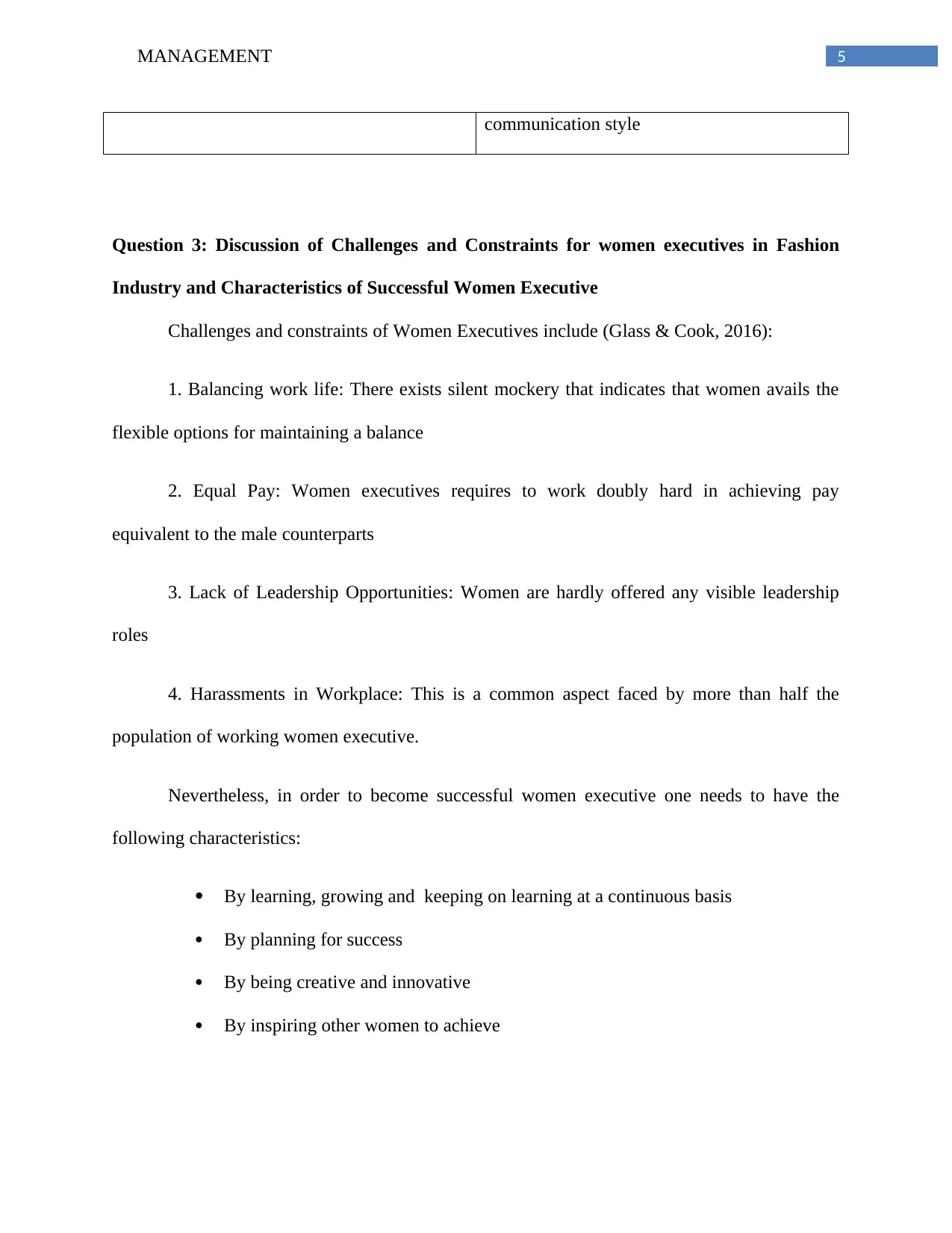
5MANAGEMENT
communication style
Question 3: Discussion of Challenges and Constraints for women executives in Fashion
Industry and Characteristics of Successful Women Executive
Challenges and constraints of Women Executives include (Glass & Cook, 2016):
1. Balancing work life: There exists silent mockery that indicates that women avails the
flexible options for maintaining a balance
2. Equal Pay: Women executives requires to work doubly hard in achieving pay
equivalent to the male counterparts
3. Lack of Leadership Opportunities: Women are hardly offered any visible leadership
roles
4. Harassments in Workplace: This is a common aspect faced by more than half the
population of working women executive.
Nevertheless, in order to become successful women executive one needs to have the
following characteristics:
By learning, growing and keeping on learning at a continuous basis
By planning for success
By being creative and innovative
By inspiring other women to achieve
communication style
Question 3: Discussion of Challenges and Constraints for women executives in Fashion
Industry and Characteristics of Successful Women Executive
Challenges and constraints of Women Executives include (Glass & Cook, 2016):
1. Balancing work life: There exists silent mockery that indicates that women avails the
flexible options for maintaining a balance
2. Equal Pay: Women executives requires to work doubly hard in achieving pay
equivalent to the male counterparts
3. Lack of Leadership Opportunities: Women are hardly offered any visible leadership
roles
4. Harassments in Workplace: This is a common aspect faced by more than half the
population of working women executive.
Nevertheless, in order to become successful women executive one needs to have the
following characteristics:
By learning, growing and keeping on learning at a continuous basis
By planning for success
By being creative and innovative
By inspiring other women to achieve
⊘ This is a preview!⊘
Do you want full access?
Subscribe today to unlock all pages.

Trusted by 1+ million students worldwide
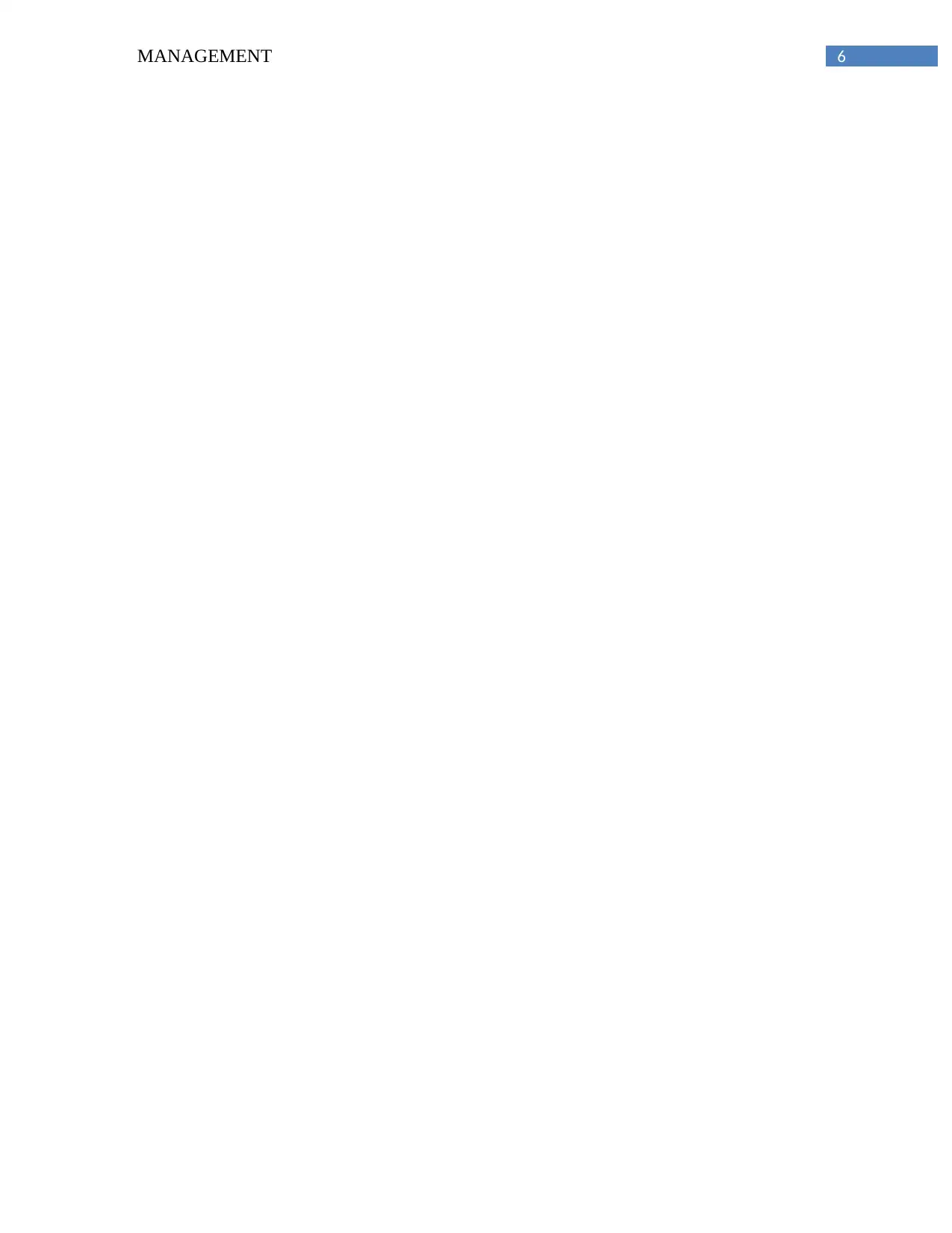
6MANAGEMENT
Paraphrase This Document
Need a fresh take? Get an instant paraphrase of this document with our AI Paraphraser
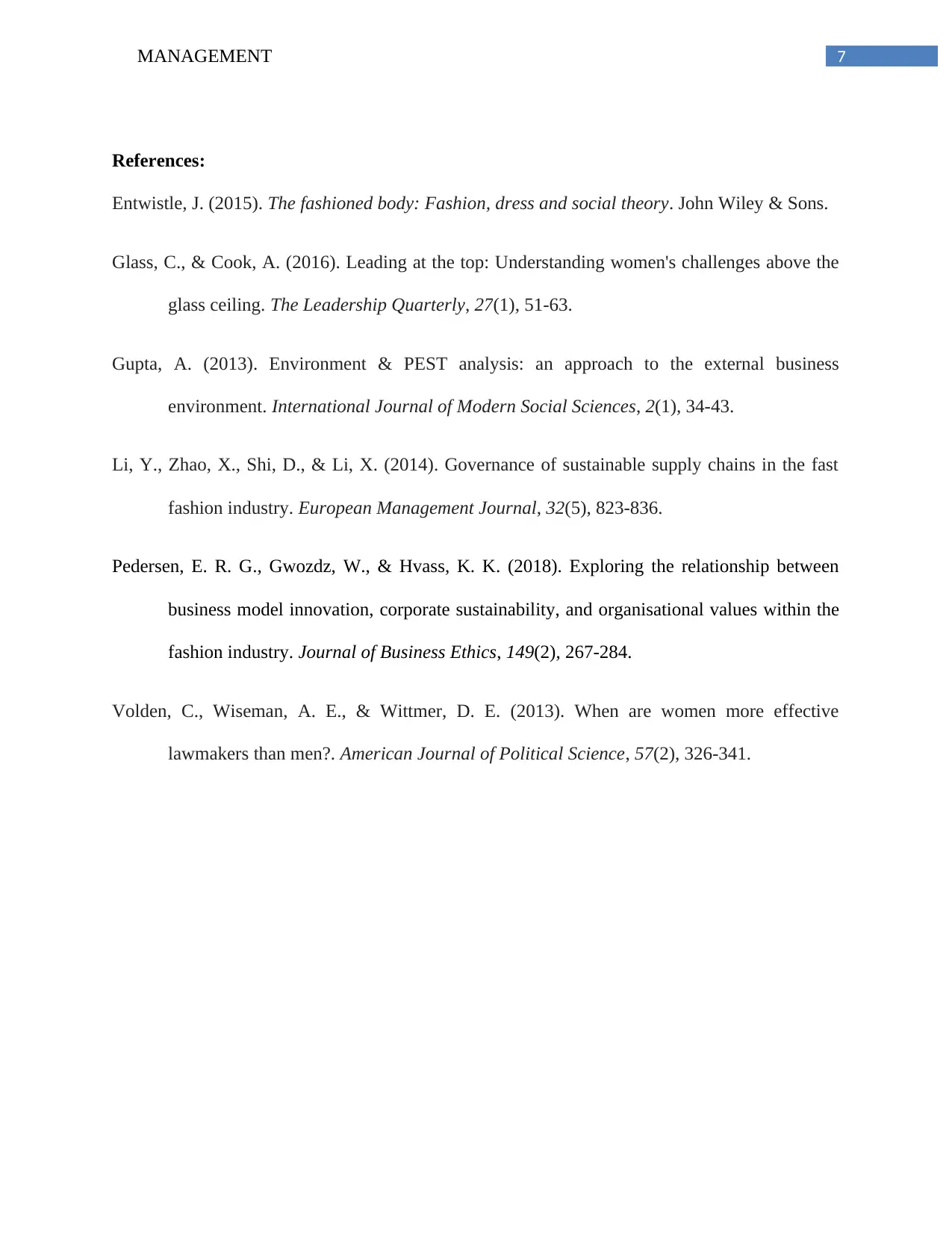
7MANAGEMENT
References:
Entwistle, J. (2015). The fashioned body: Fashion, dress and social theory. John Wiley & Sons.
Glass, C., & Cook, A. (2016). Leading at the top: Understanding women's challenges above the
glass ceiling. The Leadership Quarterly, 27(1), 51-63.
Gupta, A. (2013). Environment & PEST analysis: an approach to the external business
environment. International Journal of Modern Social Sciences, 2(1), 34-43.
Li, Y., Zhao, X., Shi, D., & Li, X. (2014). Governance of sustainable supply chains in the fast
fashion industry. European Management Journal, 32(5), 823-836.
Pedersen, E. R. G., Gwozdz, W., & Hvass, K. K. (2018). Exploring the relationship between
business model innovation, corporate sustainability, and organisational values within the
fashion industry. Journal of Business Ethics, 149(2), 267-284.
Volden, C., Wiseman, A. E., & Wittmer, D. E. (2013). When are women more effective
lawmakers than men?. American Journal of Political Science, 57(2), 326-341.
References:
Entwistle, J. (2015). The fashioned body: Fashion, dress and social theory. John Wiley & Sons.
Glass, C., & Cook, A. (2016). Leading at the top: Understanding women's challenges above the
glass ceiling. The Leadership Quarterly, 27(1), 51-63.
Gupta, A. (2013). Environment & PEST analysis: an approach to the external business
environment. International Journal of Modern Social Sciences, 2(1), 34-43.
Li, Y., Zhao, X., Shi, D., & Li, X. (2014). Governance of sustainable supply chains in the fast
fashion industry. European Management Journal, 32(5), 823-836.
Pedersen, E. R. G., Gwozdz, W., & Hvass, K. K. (2018). Exploring the relationship between
business model innovation, corporate sustainability, and organisational values within the
fashion industry. Journal of Business Ethics, 149(2), 267-284.
Volden, C., Wiseman, A. E., & Wittmer, D. E. (2013). When are women more effective
lawmakers than men?. American Journal of Political Science, 57(2), 326-341.
1 out of 8
Related Documents
Your All-in-One AI-Powered Toolkit for Academic Success.
+13062052269
info@desklib.com
Available 24*7 on WhatsApp / Email
![[object Object]](/_next/static/media/star-bottom.7253800d.svg)
Unlock your academic potential
Copyright © 2020–2025 A2Z Services. All Rights Reserved. Developed and managed by ZUCOL.





